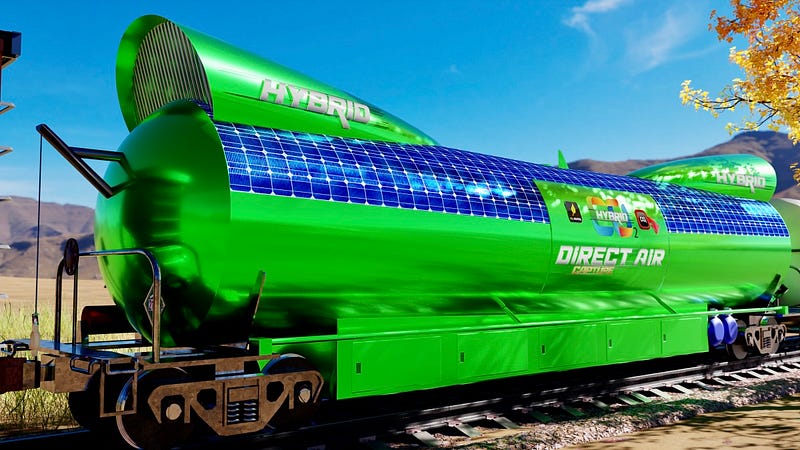Innovative Carbon-Capturing Trains: A Path to Sustainability
Written on
Chapter 1: The Carbon Dilemma
The rise of carbon dioxide emissions poses a significant threat to our environment, leading to extreme weather events, agricultural failures, and ecological degradation. To ensure a sustainable future, we must not only halt carbon emissions but also implement effective strategies for capturing and sequestering this greenhouse gas. While renewable energy sources like electric vehicles (EVs), solar, wind, and nuclear power are becoming more prevalent and promise to reduce carbon footprints, advancements in carbon capture technologies have yet to keep pace. They remain inefficient, require extensive land, and incur high costs.
Enter the innovative carbon-capturing train from CO2Rail, designed to address these challenges. But how does this unique solution work, and can it truly assist in mitigating the climate crisis?
Section 1.1: Harnessing Train Energy for Carbon Capture
The CO2Rail train car utilizes wasted energy from train operations to power its carbon capture system at no additional cost. Traditional Direct Air Capture (DAC) technologies rely on fans to maintain airflow through their systems, consuming significant amounts of energy. In contrast, these train carriages leverage the train's momentum to push air through their carbon capture units, enhancing efficiency by up to 20%.
While the trains incorporate solar panels on their roofs, these provide only a fraction of the energy needed for the intense heat cycling required in the carbon capture process. Instead, the primary power source is regenerative braking. This technology captures the kinetic energy generated by the train's movement and converts it into electrical power, similar to systems used in modern electric vehicles.
Subsection 1.1.1: The Power of Kinetic Energy

The kinetic energy of a train, which can weigh several hundred to thousands of tonnes, is significantly greater than that of a standard car. CO2Rail estimates that a single train can generate approximately 35,000 kWh of energy daily. This is equivalent to fully charging about 700 Tesla Model 3 vehicles from empty.
This remarkable energy efficiency could substantially lower the costs associated with carbon capture technologies, which often rely on expensive energy sources. By utilizing energy that would otherwise go unused, these trains can operate without increasing carbon emissions, making them a cost-effective solution.
Section 1.2: Addressing Habitat Loss and Infrastructure Issues
Another benefit of CO2Rail's carbon-capturing train is its potential to minimize habitat destruction. Conventional carbon capture facilities often require new land, leading to the displacement of natural habitats. With the urgent goal of achieving carbon neutrality by 2050, these large-scale facilities could further threaten ecosystems. However, the train's design allows it to utilize existing transportation infrastructure, mitigating the need for additional land.
Transporting captured carbon presents another challenge for traditional carbon capture technologies. Ideally, carbon could be converted into carbonate rocks and sequestered deep underground. However, this process requires extensive infrastructure for transportation, leading to additional emissions and costs. In contrast, the CO2Rail carriage can conveniently transport captured carbon directly to long-term storage sites without incurring extra expenses.
Chapter 2: The Limitations of Carbon Capture Technology
The first video titled "The Biggest Lie About Carbon Capture" delves into common misconceptions surrounding carbon capture technologies and their actual effectiveness.
The second video, "Can Carbon Capture Save Our Planet?", explores the broader implications of carbon capture and its potential to combat climate change.
While this technology appears promising, it is not without its limitations. Despite trains being more efficient than trucks, the carriages cannot capture more carbon than the train itself emits. They can nearly achieve carbon neutrality for rail travel, but they cannot make it carbon-negative.
Even with alternative power sources like hydrogen or electric batteries, the need for regenerative braking to extend range would hinder the effectiveness of these carriages, limiting their overall impact.
In conclusion, while the CO2Rail carbon-capturing train may not be the ultimate solution we hoped for in the fight against climate change, it represents a significant advancement. Rail transportation currently contributes to 4.2% of global carbon emissions, and this innovative technology has the potential to offset a substantial amount of that carbon—potentially equivalent to the annual emissions of a country like Russia. It may not be the silver bullet, but it is a critical step toward a more sustainable future.